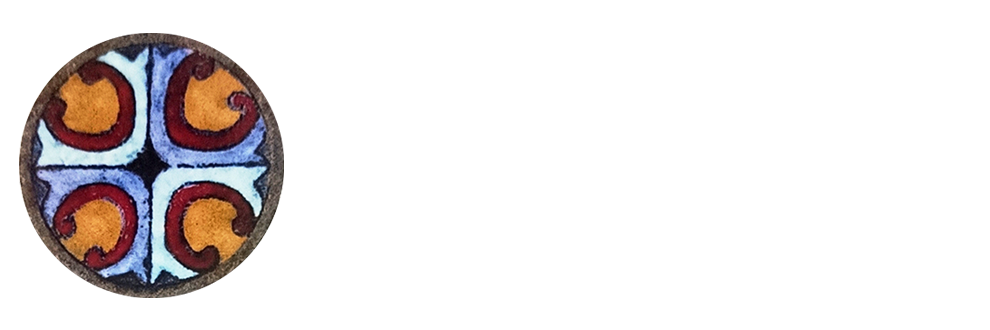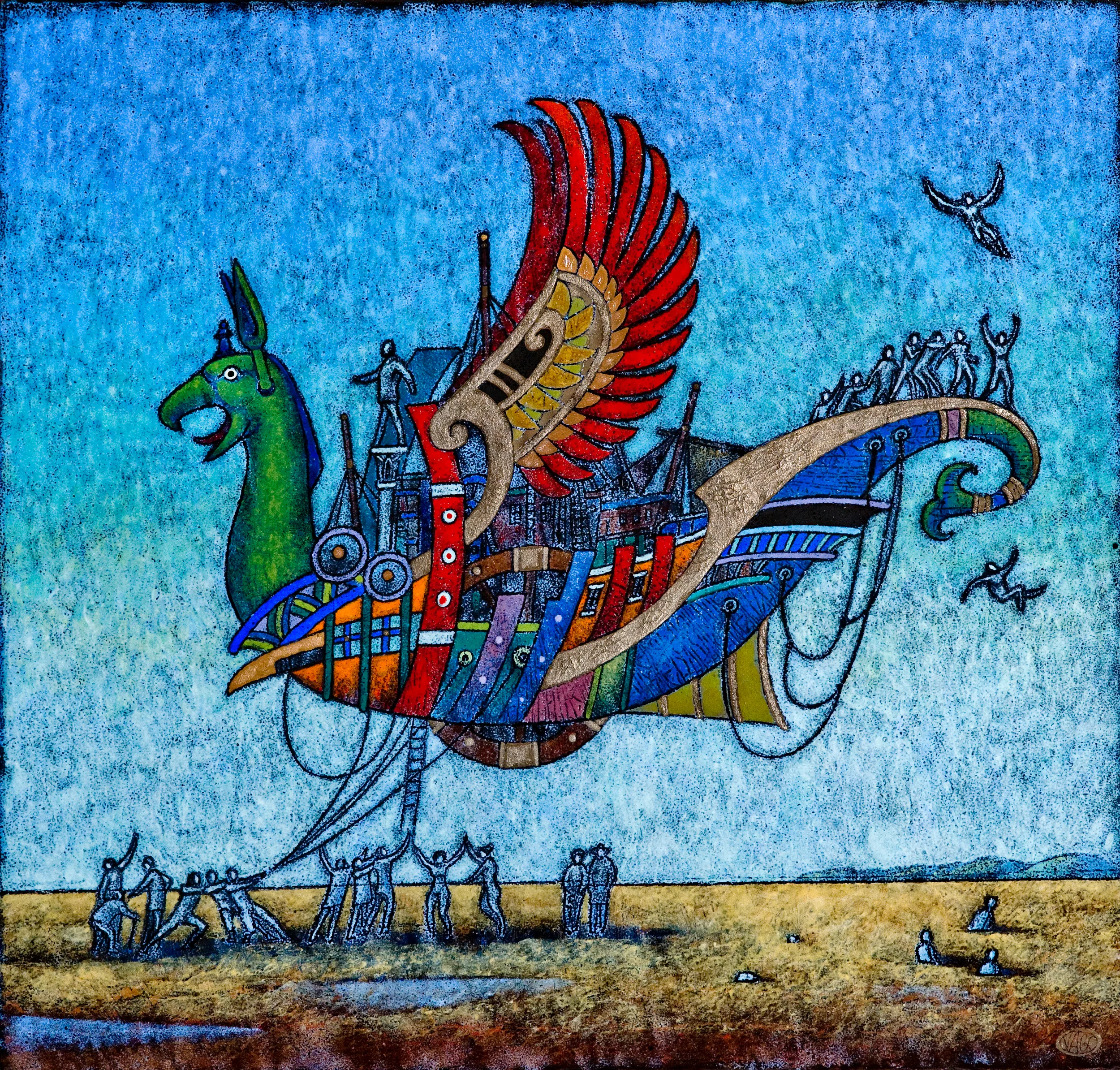NEWS | BIOGRAPY | THE ENAMEL | AWARDS | EXHIBITIONS | CINEFEST | FESTIVAL | GALLERY | WORKSHOPS | CONTACT
The Guardian of the Bluebird’s “Enamel Nest”
It might be surprising and might inspire jealousy that someone has already reached up to, and now guards the nest of the Bluebird of happiness.
It is not easy to win this “title”. A prolonged, sometimes excruciating but sometimes joyous and auspicious path leads through the spiky branches of the enamel nest to the Bluebird and to true happiness. All of István Vágó’s works radiate with this grand purpose: to find happiness – in the highest sense of the word – and to make this purpose understandable, tangible and within reach of everyone.
It is not by chance that I chose this piece of work from his portfolio. After getting to know him, I have found this work to be emblematic of, and to synthesize his artistic activity. It is the flag on the sailing boat that shows direction on the rough sea of the artist’s life, while the human being, the artist struggles to achieve the bliss and freedom of artistic creation.
Rugged life led to the “title” of the guardian of the nest. That life was paved by glittering stones of hope, and girdled with deep pits of failure and despair. His work of art combines symbolism with the knowledge and credo of the renaissance, while using the looming, wonderfully warm colours of romanticism with wide range of decorative and narrative tools. These are the visual manifestations of a deep thinker. Most of his works express his ideas by figurative elements. Their message sometimes is only interpreted by colours, or by enigmatical details, backgrounds, and non-figurative elements surrounded with motifs. Those who only dabble at the niceties may miss the fantastically precise elements which convey a profound philosophical background and historical knowledge. If you take your time to analyze all the details, you will be also gifted by the visual treat of the daring techniques.
István Vágó was born in the north of Hungary but he soon left the trouble free Tokaj hill for Budapest, where he studied window-dressing and interior design. He received a thorough education and his masters made him aware, at a young age, that he would not be allowed to waste his talents. Zsigmond Károlyi cautioned him about the tautology of intentional and unintentional. Károlyi illuminated the moving of virtual spaces by the facture with a philosophical theory that the young student immediately absorbed. It is nothing else but Hegel’s idea that: “mere repetition is the least likely to express a notion”. This is why Vágó’s subsequent works are rich in narrative details, with diverse, however, never repetitive decorative and mythological components. His other master, Ernő Tolvaly drew the young Vágó’s attention to the sensual but mental, illusionistic and conceptual possibilities of transparency, covering, and paint-overlaying. These inspirational thoughts were fervently present in the heart and mind of the young artist. They were maturing while the man struggled to make both ends meet. Thus later on, when these thoughts came to the surface and became more mature, laced with experience and historical knowledge they merged into real works of art that demonstrate thorough and experimenting techniques. As an advertisement graphic designer he gained experience in graphics and calligraphy. In 1990, together with his then wife Enikő Vágó, they found a new way of expression: enamelwork.
Within enamelwork his technique belongs to paint-enamelling which means that the enamel colours are painted directly to the metal surface. In the sphere of fine arts, this method is similar to watercolour- or oil painting. This technique has French origin, and derives from Limoges type enamel which was constantly enriched, throughout the centuries, with technological novelties. Its significance is that the base disappears while the surface becomes engulfed in colours. The works are like paintings but somewhat different since in this case the paints bake into each other, glitter, camber, and develop spatial dimension. They become enigmatical. There are no partitions or netting, no stiffness, only aquarelle-like entwining visual representations.
“To express the inexpressible”
The couple developed the technique together. Initially, they made jewellery that received public recognition in Hungary. Yet István Vágó and his wife chose to walk separate paths in order to accentuate their individual artistic expressions. They combined profound ideas with their autodidactically developed technology. They showed the innovations to the painter Mihály Kátay and to Endre Szász who both clearly supported the young talented couple. Kátay later wrote: “The case in point is the encouragement of an artist-couple who with their efforts represent a unique phenomenon in today’s enamel art. In the Hungarian tendencies of art, they unite a fine art and an applied art orientation which couples with Gulácsy’s fine art literacy, Miksa Róth’s ornamental erudition as well as with the precision and colouring typical of Samu Hibján.” (Mihály Kátay, 2000)
However, these thoughts were not popular and were not “crowned with laurel” in Hungary of that time. It was by chance that Vágó and his wife arrived in the United States with their panel pictures. In 1997, one of their young American friends, Connor Walker recommended their works for the Cherry Creek Arts Festival in Denver where – upon their first appearance in 1998 – they were awarded the first prize. Thus, a new path opened that seemed, from an Eastern European perspective, like almost a “Hollywood dream”. The pictures were symbolic and were devised from the forms of Hungarian and other, primarily European cultures. With their mysticism, extra knowledge and symbolism they found an enthusiastic audience among the art lovers of the New World. The couple received numerous prizes and awards at art festivals. They were invited to several foreign exhibitions where they took part with flying colours.
Since 2010 István Vágó has been working on his own. Neither the palette of colours, nor his experimenting spirit has become less impulsive, and the number of his international rewards has also increased. His works appear in art exhibitions both in the US and Europe.
The message of his works has changed though. It has become even more mature and more intense. The artist, disillusioned with the intrigues of history, has returned to the roots of philosophy and, as a new path, to the literature of Camus. These enrich his works with new subject-matters. He aims to present ancient mythologies in the 21st century and to visually demonstrate concepts that are difficult or impossible to put into words. His objective is “to express the inexpressible”, to point out the connection of the elements of existence by using symbols.
Although he does not like to categorize his works of art, one may dare to say by looking at his contemporary jewellery or analysing his pictures, that they represent a Pre Raphaelite-symbolist style. All of these works have a link to a different story and a prolonged constructive procedure that often alter the pieces. They implicate Miksa Róth’s decorative art and the surreal world of Gulácsy in a very delicate way. The Pre Raphaelite, romantic signs are perceptible on the figurative representations. Yet it is not the historical background or the godliness of this style that manifests itself but mere forms, the visual representation, and the decorative exuberance. The more dominant style of the works, however, is the reviving symbolism. One might say that his works portray modern symbolism, literary and mystical meaning. What prevail upon them are figurative elements, nature depictions, human figures, mystical and symbolic signs that convey different meaning to different audiences. Stories related to them not only bear suggestive, scenic or structural values, but they are also motifs that make more intense figurative elements. Thus, the visual signs in István Vágó’s works carry symbolic and also emotional meaning but they do not entirely secede from realism. They represent perpetual topics that continually fascinate people. They communicate a message to the present day and awaken us to the secret of the Bluebird.
Renáta Herczeg
art historian
2015



